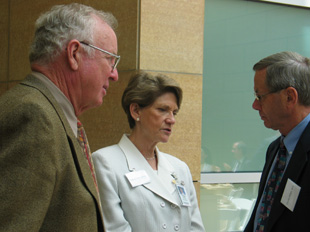 |
On Friday, UNMC Chancellor Harold M. Maurer, M.D., welcomed the Board of Regents to campus, where they heard presentations on cardiovascular surgery, UNMC’s research space, the Nebraska Epilepsy Center and UNMC’s Web-based pre-matriculation program. |
“This building will allow us to remain at the forefront nationally, in terms of educating our students,” UNMC Chancellor Harold M. Maurer, M.D., said. “Education health professionals in the 21st century will be very different than it is today, and we must provide the best opportunities for our students to succeed. Ultimately, this will benefit all Nebraskans, as they will be the ones to receive care from our graduates.”
Rubens Pamies, M.D., vice chancellor for academic affairs and dean for graduate studies at UNMC, said the Center for Health Science Education will provide the best in simulation technology and inter-disciplinary education.
 |
Regents Randy Ferlic, left, and Charles Wilson, right, talk with College of Nursing Dean Virginia Tilden, D.N.Sc. |
The 131,296-square-foot center will be built on northeast of the intersection of 42nd and Emile streets in Omaha. It will be home to the UNMC College of Medicine and will provide campus-wide education support resources. No state tax dollars will be used for construction of the building. In all, the Center for Health Science Education will cost $52.7 million, which will be paid through private donations. The UNMC Trust Fund will be used for interim funds. That cost of the center includes: construction of the new center; the demolition of properties currently on the site; the relocation of departments and units currently there; construction of a greenway along Emile Street from 42nd Street to 40th Street; the remodeling of 12,500 square feet of space in Wittson Hall, the current home of the College of Medicine; and the construction of a sky bridge across 42nd Street, from the new building to Wittson and Bennett Halls.
 |
UNMC faculty members Paul Paulman, M.D., Jane Potter, M.D., and Robert Lahue, Ph.D., with University of Nebraska at Omaha student regent Jonathan Croskey, third from left. |
The earliest possible completion for the project would be October 2006. Many of the employees in the current Computing Services building and in the 41st Street annexes would be relocated, but the earliest that the relocation would take place is April 2005.
 |
UNMC Chancellor Harold M. Maurer, M.D., University of Nebraska at Kearney student regent Brett Chloupek, University of Nebraska at Omaha student regent Jonathan Croskey, Regent Howard Hawks, Regent Kent Schroeder, J.D., UNMC student regent Ryan Arnold, Regent Charles Wilson, M.D., Regent Randy Ferlic, M.D., and Regent Don Blank, D.D.S. |
In related business on Saturday, the regents approved interim funding for relocations of the data processing equipment. The equipment is located in the Computing Services Building, which will be demolished to make way for the education center. The campus data processing equipment is being relocated to the 4230 building.